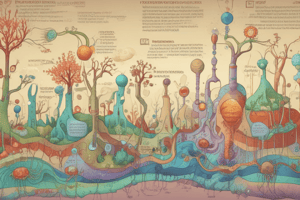Podcast
Questions and Answers
What is the primary function of pyruvate carboxylase in gluconeogenesis?
What is the primary function of pyruvate carboxylase in gluconeogenesis?
- Converting fructose 1,6-bisphosphate to fructose 6-phosphate
- Converting phosphoenolpyruvate to oxaloacetate
- Converting glyceraldehyde 3-phosphate to 3-phosphoglycerate
- Converting pyruvate to oxaloacetate (correct)
What is the function of mitochondrial transport in gluconeogenesis?
What is the function of mitochondrial transport in gluconeogenesis?
- Converting phosphoenolpyruvate to glyceraldehyde
- Transporting phosphoenolpyruvate from the cytosol to the mitochondria (correct)
- Converting pyruvate to oxaloacetate
- Regenerating ATP from ADP and Pi
What is the reaction catalyzed by phosphoenolpyruvate carboxykinase?
What is the reaction catalyzed by phosphoenolpyruvate carboxykinase?
- Oxaloacetate + GTP → Pyruvate + CO2 + GDP
- G3P + ATP → 3-PG + ADP + Pi
- Oxaloacetate + GTP → PEP + CO2 + GDP (correct)
- Pyruvate + ATP → Oxaloacetate + ADP + Pi
What is the enzyme responsible for converting 2-phosphoglycerate to 3-phosphoglycerate?
What is the enzyme responsible for converting 2-phosphoglycerate to 3-phosphoglycerate?
What is the final product of the gluconeogenesis pathway?
What is the final product of the gluconeogenesis pathway?
What is the product of the enzyme reaction catalyzed by enolase?
What is the product of the enzyme reaction catalyzed by enolase?
Flashcards are hidden until you start studying
Study Notes
Gluconeogenesis Steps
Gluconeogenesis is a metabolic pathway that generates glucose from non-carbohydrate sources. The process involves 11 steps, which can be divided into two phases: the pyruvate-to-phosphoenolpyruvate phase and the phosphoenolpyruvate-to-glucose phase.
Phase 1: Pyruvate to Phosphoenolpyruvate (Steps 1-3)
- Pyruvate carboxylase: Pyruvate is converted to oxaloacetate in the mitochondria, requiring ATP and CO2.
- Reaction: Pyruvate + CO2 + ATP → Oxaloacetate + ADP + Pi
- Phosphoenolpyruvate carboxykinase: Oxaloacetate is converted to phosphoenolpyruvate (PEP) in the cytosol.
- Reaction: Oxaloacetate + GTP → PEP + CO2 + GDP
- Mitochondrial transport: PEP is transported from the cytosol to the mitochondria.
Phase 2: Phosphoenolpyruvate to Glucose (Steps 4-11)
- Enolase: PEP is converted to 2-phosphoglycerate (2-PG) in the cytosol.
- Reaction: PEP → 2-PG
- Phosphoglycerate mutase: 2-PG is converted to 3-phosphoglycerate (3-PG).
- Reaction: 2-PG → 3-PG
- Phosphoglycerate kinase: 3-PG is converted to glyceraldehyde 3-phosphate (G3P) and ATP.
- Reaction: 3-PG + ATP → G3P + ADP + Pi
- Triosephosphate isomerase: G3P is converted to glyceraldehyde (GAL).
- Reaction: G3P → GAL
- Aldolase: GAL is converted to fructose 1,6-bisphosphate (F1,6BP).
- Reaction: GAL → F1,6BP
- Fructose 1,6-bisphosphatase: F1,6BP is converted to fructose 6-phosphate (F6P).
- Reaction: F1,6BP → F6P
- Glucose 6-phosphatase: F6P is converted to glucose 6-phosphate (G6P).
- Reaction: F6P → G6P
- Glucose 6-phosphatase: G6P is converted to glucose, which is released into the bloodstream.
- Reaction: G6P → Glucose + Pi
Studying That Suits You
Use AI to generate personalized quizzes and flashcards to suit your learning preferences.




